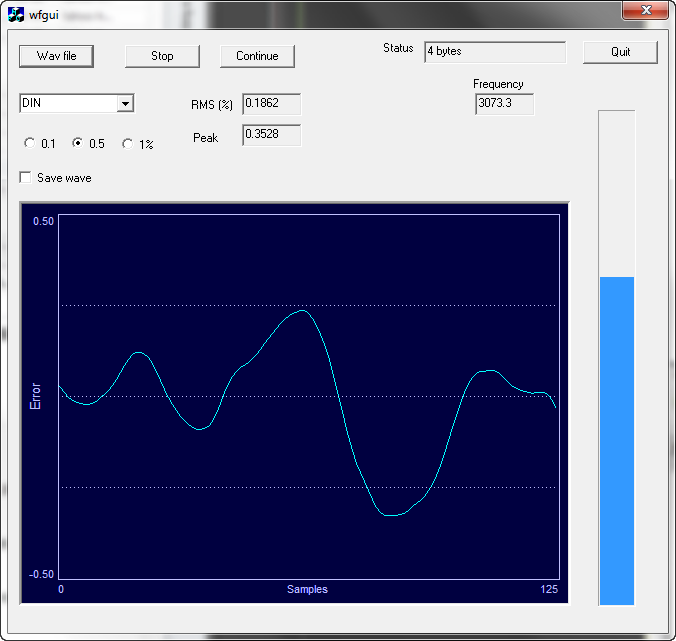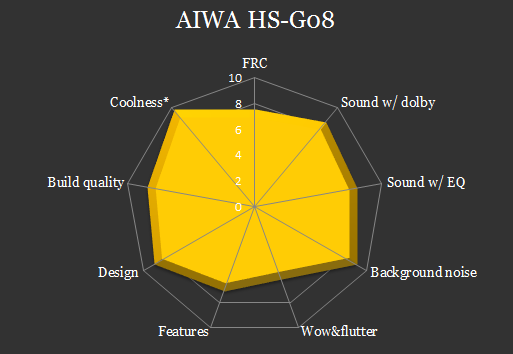|
Frequency response curve with EQ
As some players have an equalizer, it's interesting to see how it modifies the FRC, to see the real effect. In this case, I show an AIWA HS-G08 and its 5-band EQ. Let's see how every slider affects the FRC:
FRC linearized with EQ
With some players that don't have a totally plain FRC but have multi-band EQ, maybe it's possible to linearize the FRC using the EQ. That's something very interesting because the EQ setting achieved should be considered the real zero configuration. Let's see how I can achieve that plain response with an AIWA HS-G09:
Where you can see that the FRC is still not perfect, but it's better than the original.
FRC with and without Dolby
If the player has Dolby system (almost all walkmans in my collection have it), it's interesting to see how does it affect the FRC. Usually, many players cut the high frequencies when you turn it on, making the music sound dull. But this it is usually 80% a problem of the recorded tape (and thus, the recording deck), and 20%, the player.
I realized with my modded D6C by Dr Walkman: until then I always thought it was a problem of the player, but when recording with this amazing mini-deck I realized that you can have full sound range even with Dolby. Before I had it, my recordings sounded dull and the Dolby filter didn't make all the necessary changes in the recording so it can be played properly. But now I can affirm the quality of the recording affects SO much the resulting tape.
Another important thing is that a tape recorded with Dolby has to be played with Dolby. And the opposite is true too. So let's see how the FRC is when playing on an AIWA PX-303 an UX Pro recorded (on my D6C) with and without Dolby:
We can see here that the FRC is very well mantained, except a slight loss at high frequencies. If you look at the 15kHz column (shown in white) that usually corresponds with the 'hiss', you can see that it gets lowered when Dolby is active, but not so much (4 and 6 dB in each case). That's still good...
Background noise
Another important measure is the level of background noise, already explained here. Usually it's measured by analyzing the volume level present at 15kHz, that normally represents the 'hiss'.
The best decks normally achieves values of:
| - |
Without Dolby: -59dB |
| - |
With Dolby B: -66dB |
| - |
With Dolby C: -72dB |
So let's see how does it performs our AIWA PX303:
Here we see excellent values, specially for Dolby B. I admit I'm surprised specially for the Dolby B value, that I find specially high, almost at Dolby C level. Those values are probably a bit unreal and high because of the slight loss of highs when using Dolby.
.
Wow & Flutter
The last parameter to measure is the wow&flutter, already explained here. We can see here that the G08 has a RMS DIN value of 0.18, which is not bad for a walkman (considering that, i.e. a SONY B39 has about 0.29):
| Wow & Flutter |
0,186% (RMS)
0,35% (Peak) |
Here you see a screen capture of wfgui, a russian freeware that measures wow&flutter:

Final rating
So finally I listen to my reference recording (already explained here) and combine all data into a single graph, to let us quickly see all the measurements about it. In this example we see the cool AIWA G08:

AIWA HS-G08 final rating.
Where you can see the following parameters rated:
| What's rated |
How is rated |
Value |
| FRC (Frequency response curve) |
The more plain, the better the curve. |
15% |
| Sound w/Dolby |
The FRC with Dolby ON. the more plain, the better the curve. |
| Sound w/EQ* |
The possibilities of the EQ and the pleasant they are. |
| Background noise |
The lower the noise (both with and without dolby), the better the rating. |
5% |
| Wow&Flutter |
The lower W&F (so better stability of sound), the higher the rating. |
5% |
| Features |
The more (useful) features, the higher the rating. |
10% |
| Design* |
The cleaner and cooler design, the higher the rating. |
20% |
| Build quality |
The stronger the build materials, the higher the rating. |
10% |
| Coolness* |
That's a completely subjective rating to me ;-) |
35% |
NOTE: "*" indicates a subjective rating.
And, finally all values are weighted into one final (slighty subjective) value:
|
![]()
![]()
![]()
